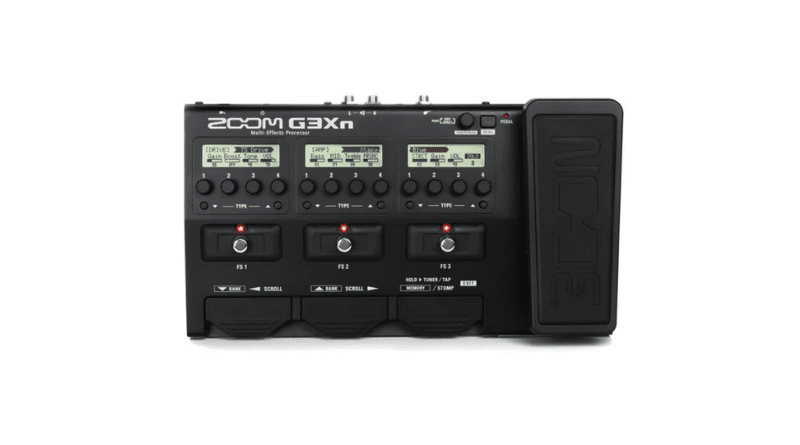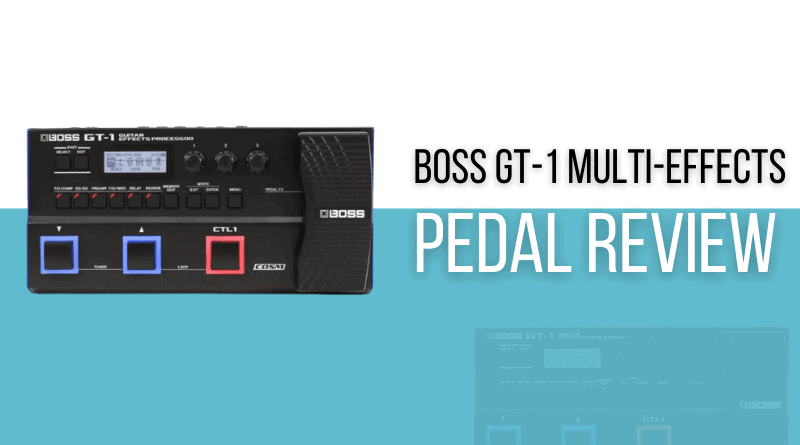Multi-FX pedals were incredibly popular in the ’90s, but quickly became something that was scoffed at by more serious musicians, who stuck to their individual stomp boxes and pedal boards. Prior to this, early digital effects processing was confined to rack-mounted units, and the overall tone quality of the pedals was questionable.
The multi-effects processor pedals of today are another story altogether, and no one unit demonstrates this better than the Boss GT-1. Boss are widely regarded for the quality of their individual pedals and their latest entry-level model promises to change the way guitarists look at multi-FX units. Keep on reading to find out what we thought of the Boss GT-1 during our in-depth review.
Read more about our review process.
Contents
Boss GT-1: Who Is This For?
The Boss GT-1 is a great pedal for beginner- to intermediate-level guitarists, although more serious musicians will still find it useful. It’s loaded with dozens of effects, so players limited by space (or who don’t have the budget to buy multiple individual pedals or amps) can access all the different FX and amp tones they need, all in one compact unit.
Boss GT-1: Appearance / Features / Controls
The GT-1 is a handsome unit. It looks very similar to high-end modeling units like the Line 6 Helix series, which is never a bad thing. It’s made with a high-quality, 2-tone plastic housing, with the bottom half of the unit being finished in a really cool purple hue. Despite the fact that the housing is plastic, it’s still rock solid. We’d have no hesitations about gigging with something like this, and nor should you.
Like most pedals, it can run on either AC power or with batteries. So in addition to the light weight making it highly portable, the flexible power options also present fewer limits on where you can use the GT-1.
There’s a small LCD screen which shows you exactly which settings are active at any given time. The screen is very basic and honestly not much improved from the types of screen found in early Zoom Multi-FX units. But we can appreciate this is one of the areas that’s allowed Boss to keep costs down.
When powering up this unit, the first thing you need to do is to select the amp type that you’ll be playing through. This will have an impact on your tone, so it’s definitely worth ensuring you have the closest possible match to your rig setup. This allows you to switch easily from a small practice amp to a full stack without experiencing any major difference in your FX tones.
The GT-1 has 3 rotary dials, an array of 10 soft-touch rubberized buttons, and 3 stomp buttons. The rubberized buttons effectively work as your signal chain. Starting from left to right, it begins with an FX/Compressor selector button, then Overdrive-type FX, and finally the preamp selector, which allows you to select from a number of famous models. The next button covers your modulation FX, then there’s a button for delay FX and one for reverb. This layout is very logical, putting the FX that need the cleanest signal at the start of the chain.
As you’d expect, there is a built-in tuner, which we found easy to use and as accurate as any other line-in tuner.
Boss GT-1: Performance/Sound
The Boss GT-1 is the baby brother of the GT-100, a fantastic modeling pedal that offers some great FX and amp sims, so we were really curious to see how the more affordable unit stacked up.
Boss products are generally all very well made and easy to use, and the GT-1 follows that pattern. While not sold as a modeler, it really feels closer to that standard than to what most would consider a traditional digital multi-FX pedal.
If you’re planning to play with stereo effects, you’ll appreciate the L/R stereo output on the GT-1. It’s very easy to set up and there are a large number of stereo FX in the presets.
One of the most appealing things about this pedal is that many of the built-in FX are actually models of famous Boss pedals. So for the price of 3-4 individual stomp boxes, you can have a full arsenal of Boss effects. The sound quality of the FX was quite something. We compared a couple of the built-in FX to their standalone pedal counterparts, including the “Blues OD” (Blues Driver), “Boss” (CS-3 Compressor), and “Rat” (Proco Rat). By and large, we could hear no noticeable difference.
Even the pedals we didn’t get a chance to compare against originals sounded great! We never got the sensation that they were overly “digital,” although this could vary depending on the amp you’re using.
Having such accurate amp models was something else we found impressive given the size of the unit. The COSM modeling technology employed by more premium Boss and Roland is featured in the GT-1, and it shows. We tested all of the built-in preamps and genuinely enjoyed them all, but our favorites were the HiGain Stack, which is modeled on a vintage Marshall, and the VO Drive, modeled on the overdrive channel of a Vox AC30.
The built-in expression pedal was definitely a nice addition, although the action wasn’t necessarily as good as something like a Dunlop Cry Baby. Despite the feeling of the pedal itself, the feature works well, controlling everything from wah to volume to modulation speed and more.
We found the companion software was simple to use, and there is an abundance (literally thousands) of patches and new FX to download to your GT-1.
Other Multi-FX Pedals to Consider
If the Boss GT-1 doesn’t seem like something you’d see yourself playing, take a look at these great alternatives:
Zoom G3XN Multi-Effects Processor

Zoom is another Japanese brand that’s been a big name in the world of multi-FX processors for some time. Their G3Xn Multi-FX Processor features 5 amp and 5 cab models, as well as 68 built-in FX. There aren’t quite as many options to choose from as on the Boss, but they are all tonally excellent. One notable advantage of the Zoom G3Xn over the GT-1 is the overall feel of the built-in expression pedal, which we found has a much more substantial action.
Line 6 POD Go Multi-Effects Processor

The Line 6 POD Go is one of our favorite multi-FX processors. With close to 300 built-in FX, it’s a clear winner for out-of-the-box tonal variety. On top of that, it boasts 8 foot switches vs 3 on both the Boss and the Zoom. These extra switches afford much more flexibility when it comes to making changes while playing live. It looks phenomenal and the high-definition screen is a joy to use. It’s quite a bit more expensive than the other options, but if you have the budget, it’s definitely worth your attention.
Final Thoughts on the Boss GT-1
The Boss GT-1 shows the huge leap in quality made in recent years when it comes to budget multi-FX processors. Not everyone has the means to afford a Kemper or a Quad Cortex. While the GT-1 doesn’t match the sound quality or versatility of those premium units, it still represents immense value for what it is – a sub-$300 digital processor with great-sounding effects, surprisingly good amp models, and excellent build quality.
Would we gig with it? Absolutely! Could you record with it? There are certainly better options out there, but you’ll still get the job done. At this price point, you couldn’t have that same confidence in many other units.


